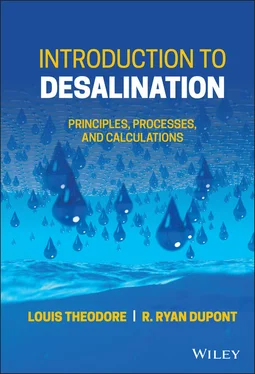3.2.4 Electrical Current – Ampere (A)
The ampere is defined as that current which, if maintained in each of two long parallel wires separated by 1 meter in free space, would produce a force between the two wires (due to their magnetic fields) of 2 × 10 -7N/m length. The SI unit of voltage is the volt (V), where one volt equals 1 W/A. The unit of electrical resistance is the ohm (Ω). One ohm equals 1 V/A.
3.2.5 Temperature – Kelvin (K)
The Kelvin is defined as the fraction 1/273.15 of the thermodynamic temperature of the triple point of water. The temperature 0 K is called absolute zero. On the commonly used Celsius temperature scale, water freezes at ambient conditions at about 0°C and boils at about 100°C. The C is defined as an interval of 1 K, and the Celsius temperature 0°C is defined as 273.15 K. On the Fahrenheit scale, 1.8°Fahrenheit is equal to 1.0°C or 1.0 K; the Fahrenheit scale uses 32°F as a temperature corresponding to °C.
3.2.6 Amount of a Substance – Mole (mol)
The mole is the amount of substance of a system that contains as many elementary entities as there are atoms and is 0.012 kg of carbon-12. When the mole is used, the elementary entities must be specified and may be atoms, molecules, ions, electrons, other particles, or specified groups of such particles. The SI unit of concentration of a substance is the mole per cubic meter (mol/m 3).
3 .2.7 Luminous Intensity – Candela (cd)
The candela is defined as the luminous intensity of 1/600,000 of a square meter of a black body at the temperature of freezing platinum (2045 K). The SI unit of light flux is the lumen (lm). A source having an intensity of 1 candela in all directions radiates a light flux of 4π lumens.
3.2.8 Supplementary Units
Two supplementary units complement these seven primary units. They include:
1 Phase angle – radian (rad). The radian is the plane angle with its vertex at the center of a circle that is subtended by an arc equal in length to the radius.
2 Solid angle – steradian (sr). The steradian is the solid angle with its vertex at the center of a sphere that is subtended by an arc of the spherical surface equal to that with sides equal in length to the radius.
3.3 SI Multiples and Prefixes
Important SI multiples and prefixes are provided in Table 3.1.
Table 3.1 SI multiples and prefixes.
| Multiples submultiples |
Prefixes |
Symbols |
|
| 1 000 000 000 000 |
10 12 |
tera |
T |
| 1 000 000 000 |
10 9 |
giga |
G |
| 1 000 000 |
10 6 |
mega |
M |
| 1000 |
10 3 |
kilo |
k |
| 100 |
10 2 |
hecto |
h |
| 10 |
10 1 |
deka |
da |
| Base unit 1 |
10 0 |
|
|
| 0.1 |
10 -1 |
deci |
d |
| 0.01 |
10 -2 |
centi |
c |
| 0.001 |
10 -3 |
milli |
m |
| 0.000 001 |
10 -6 |
micro |
µ |
| 0.000 000 001 |
10 -9 |
nano |
n |
| 0.000 000 000 001 |
10 -12 |
pico |
P |
| 0.000 000 000 000 001 |
10 -15 |
femto |
f |
| 0.000 000 000 000 000 001 |
10 -18 |
atto |
a |
A significant amount of a practicing engineer’s time is spent in converting data and equations from one set of units to another. As long as scientists provide data and information in grams and centimeters while engineers calculate in terms of pounds and feet, this confusion in terminology will continue to exist. For the most part, the units in this text are consistent with those adopted by the engineering profession in the United States.
The physical, biological, and chemical properties of materials are important considerations in any study of desalination. To promote a better understanding of such properties, many of which are covered in Chapter 04, some definitions are briefly introduced in this section. Equations used in engineering as well as in the physical sciences are dimensional equations. The choice of the fundamental system of units determines the magnitude of the quantity described. Since the choice is optional, it is usually made to suit the convenience of a certain segment of the scientific community. For example, astronomers measure distance in light years, nuclear physicists employ angstroms, engineers use feet, etc. Engineers in the United States generally employ English units, but technical individuals need to be able to convert from one system of units to another.
Information on conversion constants (sometimes referred to as conversion factors) for length, mass, time, force, pressure, volume, energy, power, concentration, viscosity, and heat capacity are provided in Table 3.2. Commonly used water and water-related conversion constants, as they relate to volume and volumetric flowrate, are provided in Tables 3.3and Table 3.4, respectively.
Table 3.2 Conversion constants.
| To convert from |
To |
Multiply by |
| Length |
|
|
| m |
cm |
100 |
| m |
mm |
1000 |
| m |
microns (µm) |
10 6 |
| m |
angstroms ( Å ) |
10 10 |
| m |
in |
39.37 |
| m |
ft |
3.281 |
| m |
mi |
6.214 x 10 -4 |
| ft |
in |
12 |
| ft |
m |
0.3048 |
| ft |
cm |
30.48 |
| ft |
mi |
1.894 x 10 -4 |
| Mass |
|
|
| kg |
g |
1000 |
| kg |
lb |
2.205 |
| kg |
oz |
35.24 |
|
ton |
2.268 x 10 -4 |
| kg |
grains |
1.543 x 10 4 |
| lb |
oz |
16 |
| lb |
ton |
5 x 10 -4 |
| lb |
g |
453.6 |
| lb |
kg |
0.4536 |
| lb |
grains |
7,000 |
| Time |
|
|
| s |
min |
0.01667 |
| s |
hr |
2.78 x 10 -4 |
| s |
day |
1.157 x 10 -7 |
| s |
week |
1.653 x 10 -6 |
| s |
yr |
3.171 x 10 -8 |
| Force |
|
|
| N |
kg-m/s 2 |
1 |
| N |
dynes |
10 5 |
| N |
g-cm/s 2 |
10 5 |
| N |
lb f |
0.2248 |
| N |
lb-ft/s 2 |
7.233 |
| lb f |
N |
4.448 |
| lb f |
dynes |
4.448 x 10 5 |
| lbf |
g-cm/s 2 |
4.448 x 10 5 |
| lbf |
lb-ft/s 2 |
32.17 |
| Pressure |
|
|
| atm |
N/m 2= Pa |
1.013 x 10 5 |
| atm |
kPa |
101.3 |
| atm |
bars |
1.013 |
| atm |
dynes/cm 2 |
1.013 x 10 6 |
| atm |
lb f/in 2= psi |
14.696 |
| atm |
mm Hg at 0°C (torr) |
760 |
| atm |
in Hg at 0°C |
29.92 |
| atm |
ft H 2O at 4°C |
33.9 |
| atm |
in H 2O at 4°C |
406.8 |
| psi |
atm |
6.80 x 10 -2 |
| psi |
mm Hg at 0°C (torr) |
51.71 |
| psi |
in H 2O at 4°C |
27.70 |
| in H 2O at 4°C |
atm |
2.458 x 10 -3 |
| in H 2O at 4°C |
psi |
0.0361 |
| in H 2O at 4°C |
mm Hg at 0°C (torr) |
1.868 |
| Volume |
|
|
| m 3 |
L |
1,000 |
| m 3 |
cm 3(cc, mL) |
10 6 |
| m 3 |
ft 3 |
35.31 |
| m 3 |
gal (U.S.) |
264.2 |
| m 3 |
qt |
1,057 |
| ft 3 |
in 3 |
1,728 |
| ft 3 |
gal (U.S.) |
7.48 |
| ft 3 |
m 3 |
0.02832 |
| ft 3 |
L |
28.32 |
| Energy |
|
|
| J |
N-m |
1 |
| J |
erg |
10 7 |
| J |
dyne-cm |
10 7 |
| J |
kW-hr |
2.778 x 10 -7 |
| J |
cal |
0.2390 |
| J |
ft-lb f |
0.7376 |
| J |
Btu |
9.486 x 10 -4 |
| cal |
J |
4.186 |
| cal |
Btu |
3.974 x 10 -3 |
| cal |
ft-lb f |
3.088 |
| Btu |
ft-lb f |
778 |
| Btu |
hp-hr |
3.929 x 10 -4 |
| Btu |
cal |
252 |
| Btu |
kW-hr |
2.93 x 10 -4 |
| ft-lb f |
cal |
0.3239 |
| ft-lb f |
J |
1.356 |
| Power |
|
|
| W |
J/s |
1 |
| W |
cal/s |
0.2390 |
| W |
ft-lb f/s |
0.7376 |
| W |
kW |
10 -3 |
| kW |
Btu/s |
0.949 |
| kW |
hp |
1.341 |
| hp |
ft-lb f/s |
550 |
| hp |
kW |
0.7457 |
| hp |
cal/s |
178.2 |
| hp |
Btu/s |
0.707 |
| Concentration |
|
|
| µg/m 3 |
lb/ft 3 |
6.243 x 10 -11 |
| µg/m 3 |
lb/gal |
8.346 x 10 -12 |
| µg/m 3 |
gr/ft 3 |
4.370 x 10 -7 |
| gr/ft 3 |
µg/m 3 |
2.288 x 10 6 |
| gr/ft 3 |
g/m 3 |
2.288 |
| lb/ft 3 |
µg/m 3 |
1.602 x 10 10 |
| lb/ft 3 |
µg/L |
1.602 x 10 7 |
| lb/ft 3 |
lb/gal |
7.48 |
| Viscosity |
|
|
| P (poise) |
g/cm-s |
1 |
| P |
cP (centipoise) |
100 |
| P |
kg/m-hrv |
360 |
| P |
lb/ft-s |
6.72 x 10 -2 |
| P |
lb/ft-hr |
241.9 |
| P |
lb/m-s |
5.6 x 10 -3 |
| lb/ft-s |
P |
14.88 |
| lb/ft-s |
g/cm-s |
14.88 |
| lb/ft-s |
kg/m-hr |
5.357 x 10 3 |
| lb/ft-s |
lb/ft-hr |
3,600 |
| Volume |
|
|
| m 3 |
L |
1,000 |
| m 3 |
cm 3(cc, mL) |
10 6 |
| lb/ft-s |
kg/m-hr |
5.357 x 10 3 |
| lb/ft-s |
lb/ft-hr |
3,600 |
| Heat Capacity |
|
|
| cal/g-°C |
Btu/lb-°F |
l |
| cal/g-°C |
kcal/kg-°C |
l |
| cal/g-°C |
cal/gmol-°C |
molecular weight |
| cal/gmol-°C |
Btu/lbmol-°F |
l |
| J/g-°C |
Btu/lb-°F |
0.2389 |
| Btu/lb-°F |
cal/g-°C |
1 |
| Btu/lb-°F |
J/g-°C |
4.186 |
| Btu/lb-°F |
Btu/lbmol-°F |
molecular weight |
Table 3.3 Conversion constants for volume.
Читать дальше












